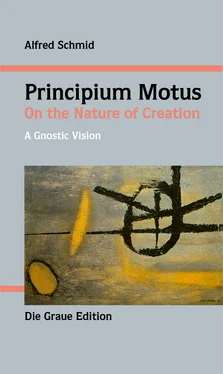DIE GRAUE EDITION
ALFRED SCHMID
PRINCIPIUM MOTUS: ON THE NATURE OF CREATION
A GNOSTIC VISION
PRINCIPIUM MOTUS

Cover page: Borris Goetz (1915 – 1998), „Satellit“ (1958)
Copyright by Stadt Zell am Harmersbach, Germany
ALFRED SCHMID
PRINCIPIUM MOTUS
ON THE NATURE OF CREATION
A Gnostic Vision

Alfred Schmid (1899 – 1968)
photograph taken in 1960
Copyright by Estate of Dr. Dietmar Lauermann

DIE GRAUE REIHE 77
Schriften zur Neuorientierung in dieser Zeit Edited by Prof. Dr. Michael Hauskeller and Dr. Florian Lauermann in collaboration with Prof. Dr. Alfred Schmid-Stiftung, Zug/Switzerland
© 2019 Die Graue Edition
Prof. Dr. Alfred Schmid-Stiftung, Zug/Switzerland
ISBN 978-3-906336-82-4
All rights reserved. Printed in Germany
Ebook-Production and Distribution: Brockhaus Commission, Kornwestheim, www.brocom.de
TABLE OF CONTENTS
WOLFRAM SCHOMMERS
INTRODUCTION
PROLOGUE
I. MOSAIC
Instead of an Introduction
On Modes of Thought
Physics and Metaphysics
Thought and Idea
The Primordial Phenomenon
The Primordial Image
The Principium
Nature as a Continuous Act of Creation
Departure
Polarity as Essence of the World
Existence as Balance
Fiat et pereat
The Displacement of the Kant-Laplacean Worldview
II. MYTH
Universe and Cosmos
The Pre-Existence of Myth
The Field
Persistence
Gravity
Flotation
Electrogravitation
Electric Persistence
The Consumer
Causality and Freedom of Action
The Breakthrough
III. FORM
The Signpost
Striving as a Primordial Phenomenon
The Self-Directedness of Strivings in Cosmos and Nature
The Goal-Orientation of Self-Directed Strivings
All-Relatedness
Field Velocity and Light Ray
The Universe as a Holistic Inertial System
Causa Finalis or the Marvel of Autonomous Nature
The Synchronism Axiom
The Third Factor
IV. APPENDIX
Wolfram Schommers Postscript
INTRODUCTION
Matter and mind have always been discussed and investigated in many different facets, but at the end of the day a solution that satisfies everyone is yet to be found. There is, however, an urgent need to explore the issue because modern technologies will, already in the near future, allow us to operate on a level which in all likelihood forms the basis of mental and spiritual states. In order to assess what we are actually doing when we engage in such novel experimental activities, we need to know more about the mind ’s origin and significance and what its relation is to ordinary matter. With this monograph, Alfred Schmid presents a ground-breaking and exciting approach to solve the matter-mind problem.
It is well known that Descartes proposed we understand mind and matter as two connectionless elements, each part existing independently of one another. Yet this view raises serious problems and today has at best historical value. It is common to try and explain mental-spiritual states with the methods of modern theoretical physics by means of specific models. Mind is then based on the material level, and mental-spiritual states are merely secondary phenomena that are not really fundamental. Alfred Schmid rejects such attempted explanations and positively turns the matter upside down by suggesting exactly the opposite approach. According to him, the transcendental produces the material states. What can Alfred Schmid ’s wisdom give us? Not only can it strengthen the individual sense of self-worth, but it can also tie in with the possible potential of so-called nano-technology and give content and direction to all of this. Some brief remarks on this:
A few decades ago, the controlled manipulation of atoms was accomplished. This was the birth of nanotechnology, which currently runs all over the world through a highly accelerated development phase. This new technology is, so to speak, the very basis of everything that immediately affects man in the material domain. There is no level of development above that of nanotechnology. We are now capable of developing materials whose astounding properties can be defined absolutely: this is not only the strongest material that has ever been produced, but the strongest material that it is generally possible to produce. There is nothing above and beyond.
Yet nanotechnology also wants to affect brain functions on an atomic level, and it does so very decidedly and with the above-mentioned claim to absoluteness. “Computational neurogenetics ” is a new line of research that, within a nanotechnological framework, mathematically examines brain functions with the purpose of enabling us to demonstrate what needs to be done on an atomic level to remedy functional defects in the brain, which expressly includes the mental-spiritual domain. If there is to be a connection between mind and matter, then it surely manifests itself on this absolute, nanotechnological level. In this situation, we must give attention not only to the basis of matter, but we must also look into the origin of the mental-spiritual states and attempt to explain the connection that exists between mind and matter. Alfred Schmid’s approach is unusual, but this also means that it is very different from the existing, less successful attempted solutions. It can provide orientation especially to those nanotechnological activities. In this respect, Schmid ’s world view is highly topical. Although Schmid does not commit to the customary standards of modern theoretical physics, he does not violate them either, which means, however, that some of the details he provides will prove to be in need of correction. In the form presented here, his remarks are kept general, as it was already his practice in his 1957 monograph The Marvel of Light. His worldview is comprehensive and largely eliminates the difficulties that arise in the context of standard physics. To make this easier to see, let us briefly consider the current situation in standard physics.
The problem of modern theoretical physics is that it claims to be able to describe the world in its entirety. The current state is all too clearly reflected when Steven Hawking, without provoking any meaningful objections from his colleagues, asserts that we will soon hold “God’s plan” in our hands. It also makes it obvious how inappropriate that claim is. And yet public opinion follows the same line, I suppose mainly because our technological achievements are indeed stupendous. That is convincing, so it seems to follow logically that we should be able to describe the world in its entirety. It is a fact that physics gives us the foundations for all technological developments, many of which are no doubt fantastic, breathtaking and also helpful. On the other hand, however, the more we advance in this process, the more lucre and the acquisition and exhibition of luxury are pushed to the fore. Those who are in possession of this wealth and luxury certainly don’t mind, and many who are not would not mind either. The trend is clear!
Читать дальше















